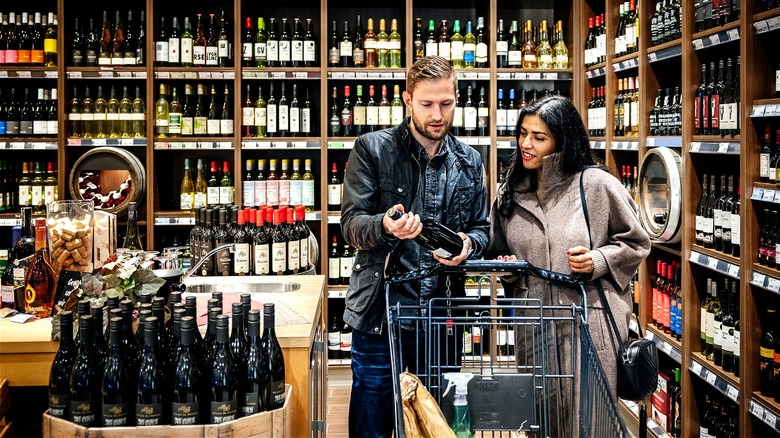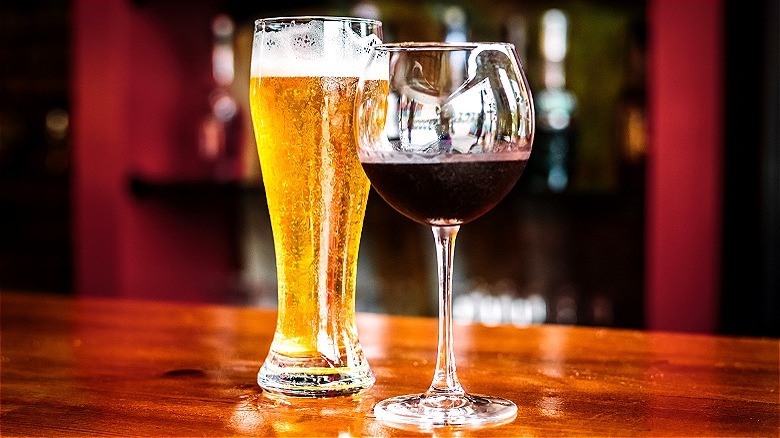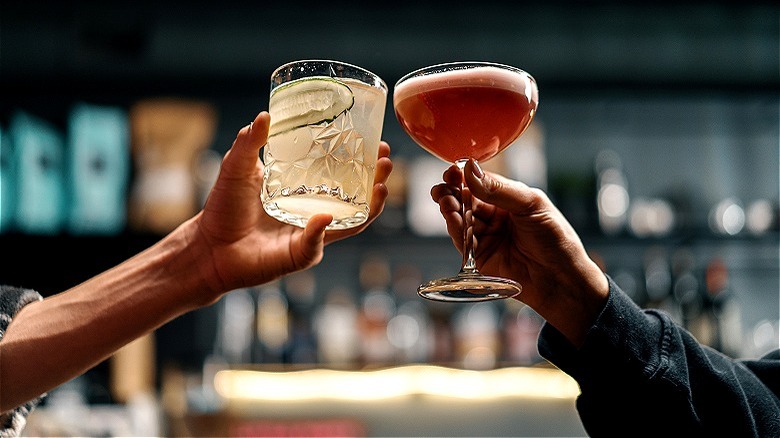Here's How Much The Average American Spends On Alcohol Each Year
One of the many things that enjoyed a surge in popularity during the pandemic (beyond sourdough bread and Zoom) was alcohol. From virtual cocktail hours to memeable celebrity recipes, drinking became a shared experience for many during a dark time. In fact, data from the University of Buffalo found that United States alcohol sales increased by as much as 20% to 40% in some states during the pandemic (while, notably, beer sales declined). Retail alcohol sales from March to September 2020 totaled $41.9 billion, a 20% increase over the same period the year before. It's safe to say people were drinking quite a bit more than they were pre-pandemic.
However, while alcohol sales experienced booms during the pandemic, post-pandemic sales have been mixed. While total retail spending on alcoholic beverages in 2023 came to $89.8 billion, this represented just a 1.1% increase over 2022. According to the Bureau of Labor Statistics, Americans spent less on alcohol (as a percentage of their total expenditures) but still ended up spending more overall thanks to inflation, with Americans spending an average of $583 on alcohol in 2022.
In addition to a general slowing in people's alcohol consumption in America, though, the growing popularity of movements like Dry January, combined with shifting consumer tastes surrounding what kind of products they prefer, has shaken up (pun intended) the alcoholic beverage market in recent years. While both beer and wine experience volume declines, new categories like ready-to-drink beverages (which include everything from premade cocktails to spirits seltzers to hard sodas) have experienced impressive growth.
Beer and wine
Not all forms of alcohol experienced the same increase or post-pandemic decrease in sales. For instance, beer and wine have experienced different sales trajectories from hard alcohol. Noticeably, beer has been on the decline for decades. Yet, while beer sales have been down lately, it's important to realize that the decline in beer's market share has been a long time coming rather than a direct result of the pandemic.
According to data from the Distilled Spirits Council of the United States, beer accounted for 55.5% of the total alcohol industry market share in 2000 but has been slowly declining to 2023's market share of 42.2%. Even within the existing market share, there have been noticeable upsets that have shifted consumer tastes and preferences. Specifically, the backlash against a Bud Light advertising campaign featuring transgender influencer Dylan Mulvaney pushed Modelo into the top spot among American consumers for the first time. Sales of imported beer increased by $1 billion (up 9.1%) in 2023.
Wine, on the other hand, has maintained a relatively flat market share since 2000 of around 16%. While the market, especially the e-commerce wine market, experienced astronomical growth during the pandemic, sales have since plateaued. According to data from NIQ, wine retail sales dropped in 2023 by 1.4%, bringing the annual sales total to $19.5 billion. However, wine-based ready-to-drink cocktails and canned wine beverages have grown 20%, meaning the wine market will more likely maintain or even grow its market share in the coming years.
Popularity of spirits
Per its annual economic briefing, the Distilled Spirits Council of the United States finds the spirits category is still growing, albeit barely. While volume grew 1.2%, revenue remained mostly flat with just a 0.2% increase over the year before. Spirits sales in America totaled $37.7 billion in 2023. Chris Swonger, president and CEO of DISCUS, explained to CNBC, "The spirits sector showed resilience in 2023, navigating through the choppy wake of the pandemic and maintaining our market share lead of the total beverage alcohol market. The phenomenal sales growth we saw during the pandemic was unprecedented and unpredictable but also unsustainable, and now, the spirits market is recalibrating."
It's also worth mentioning which spirits have been growing in popularity. While Vodka remained America's top-selling spirit for 2023, the second-highest-selling category, tequila and mezcal, has been consistently growing. In fact tequila and mezcal put up an even bigger lead (by gaining 7.9% in revenue in 2023) on American-made whiskey, which was the third-highest-selling category.
However, nowhere has revenue growth in alcohol been more noticeable than with ready-to-drink cocktails and mixes. The ready-to-drink category had a staggering 26.8% revenue increase over 2022 numbers, while spirits-based ready-to-drink beverages have also started to outgrow and outpace the previously popular malt-based beverage field (bolstered by the growth of hard seltzers). There's also been a growing popularity of non-alcoholic beer, wine, and cocktail beverages. Alcohol-free drinks have become one of the fastest-growing markets, with sales growing 35% for a retail total of $565 million in 2023. Whatever you order, don't forget to tip your bartender.


